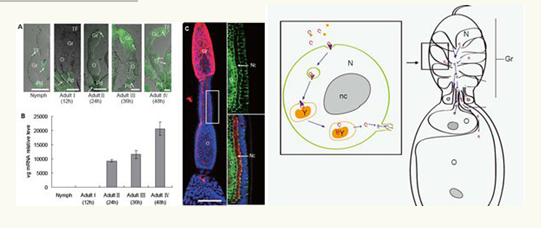Scientists reveal a new mechanism of transovarial transmission
Researchers at the Institute of Plant Protection (IPP) of Chinese Academy of Agricultural Sciences (CAAS), collaborating with researchers from Chinese Academy of Sciences (CAS) and Fujian Agriculture and Forestry University (FAFU), have made a breakthrough on the mechanism of transovarial transmission of a plant virus.
According to Dr Wang Xifeng, professor at IPP and the program head, researchers used several techniques, including yeast two-hybrid systerm, immunofluorescence, immunoelectron microscopy and RNA interference, to verify the Rice stripe virus (RSV) ingeniously utilizing the vitellogenin (Vg) of the small brown planthopper (Laodelphax striatellus) to invade nurse cells in the germarium of ovary, then spread to the oocyte through the nutritive cord for completing transovarial transmission.

Many viruses, especially plant viruses, are transmitted by insects. Several mechanisms of transmission are involved in the specific interactions between viruses and insect vectors. RSV, as a member of the genus Tenuivirus, is responsible for significant yield losses in rice production in temperate and subtropical East Asia, which is transmitted by the L.striatellus in a persistent-propagative manner and from parents to offsprings through eggs. But the mechanism of this transovarial transmission remains unclear.
The researchers firstly obtained the vitellogenin which interacted with nucleocapsid protein of RSV by yeast two-hybrid. Accompanied by the expression of Vg, RSV appeared in the anterior part of germarium, then spread into most parts of the germarium and the ooecium. RSV and Vg colocalized with each other, forming some small colocalization spots in the germarium of the ovariole. With time, more colocalization spots of RSV RNPs and Vg gradually accumulated and enlarged and were finally distributed throughout the germarium of insects. It is obviously that Vg is an important component for RSV to overcome the transovarial transmission barrier. RNA interference suggested that the knockdown of vg expression specifically affected the accumulation of RSV in the ovariole of the insect. Based on all the data obtained, they proposed a model for the RSV transovarial transmission in L. striatellus. Above all, RSV binds to Vg outside the ovariole to form a complex. Then, the complex is transported into the nurse cells in the germarium via endocytosis. Finally, RSV in the nurse cells spread into the growing oocytes with or without binding with Vg through the nutritive cords. Taken together, RSV can use existing transovarial transport systems in female insects for its own purposes.
This result might also be applied to other persistent-propagative animal and plant viruses transmitted by arthropods and perhaps to some bacteriocytes in other insects. Given the implications of the transovarial mechanism for viral evolution and epidemiology, the results urgently call for a broader investigation of this important trait in a wide panel of natural virus–host associations.
This work was supported by the National Key Basic Research of China (2010CB126200) and the Natural Science Foundation of China (NSFC31071664).
The research result was published in PLoS Pathogens, 2014, 10(3): e1003949.
http://www.plospathogens.org/article/info:doi/10.1371/journal.ppat.1003949.
-
 China-Laos Training Workshop on Integrated Management of Destructive Crop Pests and Diseases Successfully held in Laos
China-Laos Training Workshop on Integrated Management of Destructive Crop Pests and Diseases Successfully held in Laos -
 New Plant Protection: New challenge and new opportunity for plant protection
New Plant Protection: New challenge and new opportunity for plant protection -
 International and SELAMAT Conference on Pesticide Residue and Mycotoxin Contamination Held in Beijing
International and SELAMAT Conference on Pesticide Residue and Mycotoxin Contamination Held in Beijing -
 CAAS President Meets Chairman of ASEAN FAW Taskforce
CAAS President Meets Chairman of ASEAN FAW Taskforce
